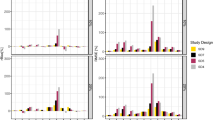Abstract
A sequential estimation procedure is presented which uses optimal sampling times to estimate the parameters of a model from data obtained from a group of subjects. This optimal sampling sequential estimation procedure utilizes parameter estimates from previous subjects in the group to determine the optimal sampling times for the next subject. Parameter estimates obtained from the optimal sampling procedure are compared to those obtained from a conventional sampling scheme by using Monte Carlo simulations which include noise terms for both assay error and intersubject variability. The results of these numerical experiments, for the two examples considered here, show that the parameter estimates obtained from data collected at optimal sampling times have significantly less variability than those generated using the conventional sampling procedure. We conclude that optimal sampling and preexperiment simulation may be useful tools for designing informative pharmacokinetic experiments.
Similar content being viewed by others
References
J. Myhill. Investigation of the effect of data error in the analysis of biological tracer data from three compartment systems.J. Theor. Biol. 23:218–231 (1968).
W. J. Westlake. Problems associated with analysis of pharmacokinetic models.J. Pharm. Sci. 60:882–885 (1971).
W. J. Westlake. Use of statistical methods in evaluation ofin vivo performance of dosage forms.J. Pharm. Sci. 62:1579–1589 (1973).
H. G. Boxenbaum, S. Riegelman, and R. M. Elashoff. Statistical estimation in pharmacokinetics.J. Pharmacokin. Biopharm. 3:123–148 (1974).
P. J. Fell and M. T. Stevens. Pharmacokinetics—uses and abuses.Eur. J. Clin. Pharmacol. 8:241–248 (1975).
C. M. Metzler, G. L. Elfring, and A. J. McEwen.A User's Manual for NONLIN and Associated Programs. Upjohn Co., Kalamazoo, Mich., April 20, 1974.
F. Mori and J. J. DiStefano, III. Optimal nonuniform sampling interval and test-input design for identification of physiological systems from very limited data.IEEE Trans. Automat. Control 24:893–900 (1979).
J. Gaillot, J. J. Steimer, A. J. Mallet, J. J. Thebault, and A. Beider. A prior lithium dosage regimen using population characteristics of pharmacokinetic parameters.J. Pharmacokin. Biopharm. 7:579–628 (1979).
P. K. Wilkinson, A. J. Sedman, E. Sakmar, R. H. Earhart, D. J. Weidler, and J. G. Wagner. Blood ethanol concentrations during and following constant-rate intravenous infusions of alcohol.Clin. Pharmacol. Ther. 19:213–223 (1976).
K. J. Himmelstein and J. F. Gross. Mathematical model for cyclocytidine pharmacokinetics.J. Pharm. Sci. 66:1441–1444 (1977).
J. J. Lima, D. R. Conti, A. L. Goldfarb, W. J. Tilstone, L. H. Golden, and W. J. Jusko. Clinical pharmacokinetics of procainamide infusions in relation to acetylator phenotype.J. Pharmacokin. Biopharm. 7:69–85 (1979).
L. B. Sheiner, B. Rosenberg, and V. V. Marathe. Estimation of population characteristics of pharmacokinetic parameters from routine clinical data.J. Pharmacokin. Biopharm. 5:445–479 (1977).
G. E. P. Box and H. L. Lucas. Design of experiments in nonlinear situations.Biometrika 46:77–90 (1959).
R. K. Mehra. Optimal input signals for parameter estimation in dynamic systems—survey and new results.IEEE Trans. Automat. Control 19:753–768 (1974).
G. E. P. Box, W. G. Hunter, and J. S. Hunter.Statistics for Experimenters: An introduction to Design, Data Analysis, and Model Building. John Wiley & Sons, New York, 1978, pp. 546–554.
D. Z. D'Argenio and A. Schumitzky. A program package for simulation and parameter estimation in pharmacokinetic systems.Comput. Programs Biomed. 9:115–134 (1979).
F. C. Schweppe.Uncertain Dynamic Systems, Prentice-Hall, Englewood Cliffs, 1973, pp. 367–385.
M. J. Box. Some experience with a nonlinear experimental design criterion.Technometrics 12:569–588 (1970).
M. Rowland, P. D. Thomson, A. Guichard, and K. L. Melmon. Disposition kinetics of lidocaine in normal subjects.Ann. N.Y. Acad. Sci. 179:383–398 (1971).
International Mathematical and Statistical Libraries, Inc. Library 2, Houston (1977).
M. Hollander and D. A. Wolfe.Nonparametric Statistical Methods, John Wiley & Sons, New York, 1973, pp. 26–33.
A. A. Afifi and S. P. Azen.Statistical Analysis: A Computer Oriented Approach, Academic Press, New York, 1972, pp. 54–57.
W. J. Hill, W. G. Hunter, and D. W. Wichern. A joint design criterion for the dual problem of model discrimination and parameter estimation.Technometrics 10:145–160 (1968).
Author information
Authors and Affiliations
Rights and permissions
About this article
Cite this article
D'Argenio, D.Z. Optimal sampling times for pharmacokinetic experiments. Journal of Pharmacokinetics and Biopharmaceutics 9, 739–756 (1981). https://doi.org/10.1007/BF01070904
Received:
Revised:
Published:
Issue Date:
DOI: https://doi.org/10.1007/BF01070904




